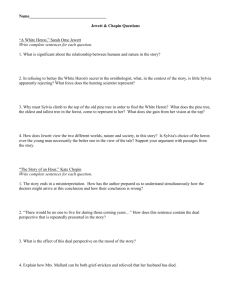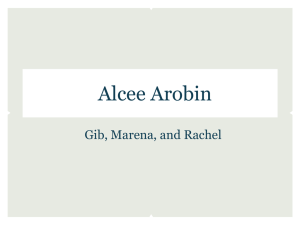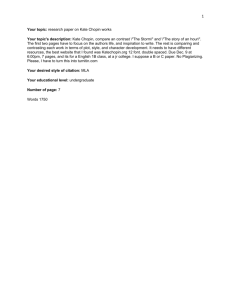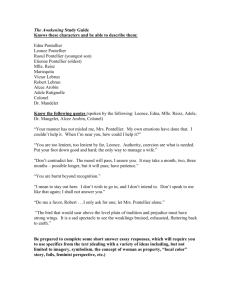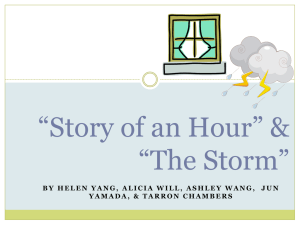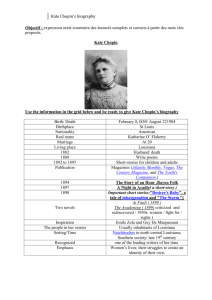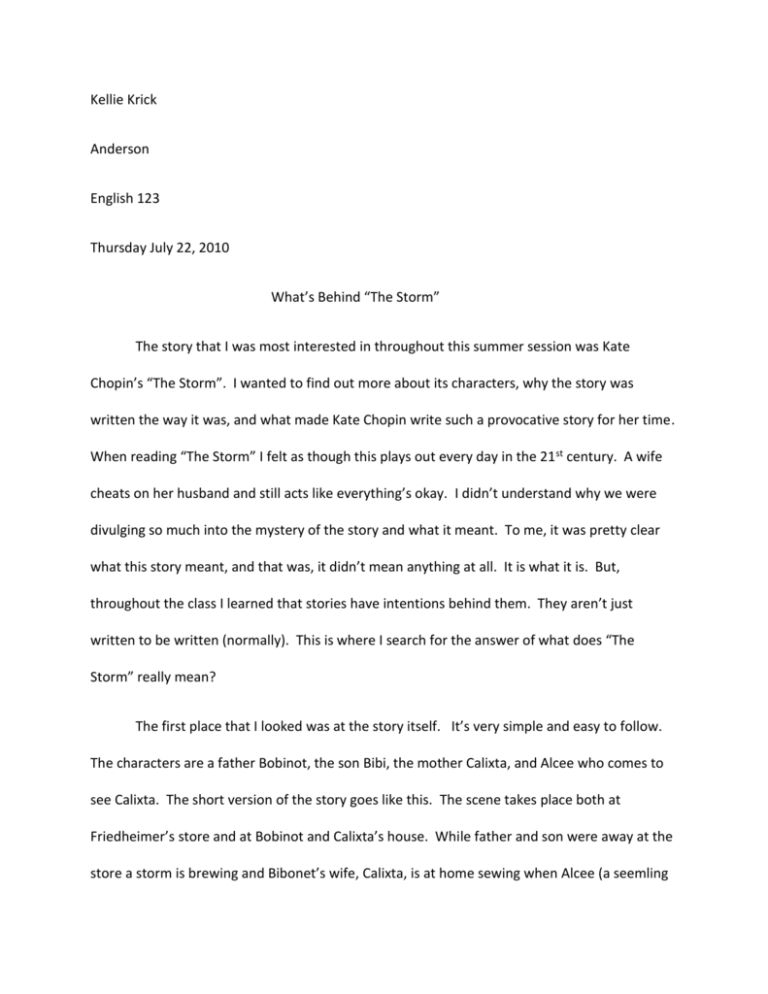
Kellie Krick
Anderson
English 123
Thursday July 22, 2010
What’s Behind “The Storm”
The story that I was most interested in throughout this summer session was Kate
Chopin’s “The Storm”. I wanted to find out more about its characters, why the story was
written the way it was, and what made Kate Chopin write such a provocative story for her time.
When reading “The Storm” I felt as though this plays out every day in the 21 st century. A wife
cheats on her husband and still acts like everything’s okay. I didn’t understand why we were
divulging so much into the mystery of the story and what it meant. To me, it was pretty clear
what this story meant, and that was, it didn’t mean anything at all. It is what it is. But,
throughout the class I learned that stories have intentions behind them. They aren’t just
written to be written (normally). This is where I search for the answer of what does “The
Storm” really mean?
The first place that I looked was at the story itself. It’s very simple and easy to follow.
The characters are a father Bobinot, the son Bibi, the mother Calixta, and Alcee who comes to
see Calixta. The short version of the story goes like this. The scene takes place both at
Friedheimer’s store and at Bobinot and Calixta’s house. While father and son were away at the
store a storm is brewing and Bibonet’s wife, Calixta, is at home sewing when Alcee (a seemling
random character) wonders up to the house. Calixta allows for Alcee to come in the house
where they end up having an affair. Alcee rides off happy and Bobinot and Bibi come home to a
happy wife.
The first question that I had in regards to this story was where did these characters
come from? When reading the story, Alcee seemed to come out of nowhere. I remember in
class we were discussing on how Calixta knew Alcee and why did he randomly come riding up to
her home? Come to find out, “The Storm” is actually a sequel to the story “At the ‘Cadian Ball”.
“At the ‘Cadian Ball” is really the story of how Calixta and Bibonet got together and how Alcee
came into her life. Calixta, Bibonet, and Alcee were all at attendance at the ‘Cadian Ball and
Alcee and Calixta were eyeing each other, but as quickly as Alcee came into the ball, he left
quickly as well! For Alcee was really interested in dating his cousin Clarisse. But when Clarisse
denied him, Alcee took off to the ball where he flirted with Calixta. When Clarisse found out
Alcee was going to the ball she took off after him. When Clarisse got there she called Alcee
saying it was an emergency and to come quick, but really it was just to get Alcee away from
Calixta and tell Alcee that she loved him.
“It was he, then, who, an hour ago was kissing little Calixta’s ear and whispering
nonsense into it. Calixta was like a myth, now. The one, only, great reality in the world
was Clarisse standing before him, telling him that she loved him”.
In the event of Alcee’s quick arrival and departure, Calixta had no choice, but to marry and be
with Bibonet.
After reading “At the ‘Cadian Ball” it all makes sense how Alcee knew where
Calixta lived and why their meeting transpired the way it did. Calixta had feelings for Alcee
when she was at the ball. They flirted and were having fun and Calixta seemed to really see
herself with Alcee. When Alcee left to be with Clarisse, Calixta left the ball only to end up with
Bibonet, who she casually and somewhat unwillingly told she would marry him.
"I don' care; it 's got to go in the tub, anyway. You been sayin' all along you want to
marry me, Bobinôt. Well, if you want, yet, I don' care, me."
The glow of a sudden and overwhelming happiness shone out in the brown, rugged face
of the young Acadian. He could not speak, for very joy. It choked him.
"Oh well, if you don' want," snapped Calixta, flippantly, pretending to be piqued at his
silence.
"Bon Dieu! You know that makes me crazy, w'at you sayin'. You mean that, Calixta? You
ent goin' turn roun' agin?"
"I neva tole you that much yet, Bobinôt. I mean that. Tiens," and she held out her hand
in the business-like manner of a man who clinches a bargain with a hand-clasp. Bobinôt
grew bold with happiness and asked Calixta to kiss him. She turned her face, that was
almost ugly after the night's dissipation, and looked steadily into his.
"I don' want to kiss you, Bobinôt," she said, turning away again, "not to-day. Some other
time. Bonté divine! ent you satisfy, yet!"
"Oh, I 'm satisfy, Calixta," he said.
Her hope in marrying somebody was really for Alcee all along, but because he left to be
with Clarisse, she had no choice but to marry Bibonet. When Alcee rode up to her house on
that (un)faithful day, both knew what was about to happen. They still had a love and passion
for each other that had been building since their encounter at the ball. It was only a matter of
time where Alcee was going to take that opportunity to have Calixta.
After seeing how the two stories came together, I disagree with our discussion on that
Calixta didn’t care about having sex with Alcee because now she was married and could have
sex. I think that she wanted to be with Alcee all along and she would have been with Alcee if he
hadn’t gone off with Clarissa. It’s like having that fling that you can’t get over and end up
cheating on your boyfriend just to have a sexual encounter with that fling. Back then people
could not necessarily marry for love, but for stability financially and property wise. I think that
“the storm” has to do with her sexuality, but it was her sexuality that was built up for Alcee all
along. I don’t believe that she would have done this with another man. She settled for Bibonet
and still had love or lust for Alcee.
After dissecting The Storm’s characters, “The Storm” by itself seems so simple, but in
1898 when the story was written, the sexual drive behind this story is what made it seem so
risqué. As women in 1898, they were not supposed to have affairs and sexual desires such as
Calixta did in this short story. The thought of sexual desires in that period were only thought to
be had by men and even so, should not be written about by women about women having
thoughts of a sexual nature. She is said to have been a pioneer in the feminist movement with
her writings, but even so, her stories (because of their topics) were widely criticized
So why did Kate Chopin write about such a provocative subject? For this question I had
to do some research about her life. It was found that she was raised mainly by women, her
mother, grandmother, great-grandmother and the nuns at the schools she went to. This, in
turn, would seem to me that women and the cultures and attitudes of women would have an
impact on her life. When Kate was 20 years old she got married and moved to Louisiana. In a
journal she wrote before she was to wed, “I am going to be married, married to the right man.
It does not seem as strange as I thought it would—I feel perfectly calm, perfectly collected…” I
actually found this funny, especially after reading “The Storm” because she obviously had an
idea in her head of what marriage was “suppose” to be like. She was supposed to be married
to the “right man”, to be calm and happy, and of course collected so she could take care of her
family. But by the time she was 29 she had 6 children and was a widow by 32. Probably never
expected that to happen! I myself, only 22, have never been married nor do I have any children.
But I can imagine the burden of women in her time where expectations dictated your life. It
seems that for this question, why write such provocative stories, can be answered by saying
that she did this because she needed an escape from the life of being a woman and from the
constraints of womanhood. Being pregnant for 8 years of her marriage (from 1871-1879) you
could imagine that sexual desire was lacking in her life. Especially when her husband died in
1882, which meant that she had 6 children ranging in age from 11-3, there is no better escape
than to live vicariously through the writings of a woman who can have an affair and feel happy
afterward.
All in all I have found that there is meaning behind “The Storm”. But, I really found it
through reading the stories, “At the ‘Cadian Ball” and “The Storm” together, that Calixta was a
woman who had to settle with what was handed to her. This, I believe, shadows Kate’s life
where she had to marry a well off man as did Calixta. Do I believe that Kate Chopin wrote this
as sort of an autobiography, no, but do I think that she wrote this because she felt some sort of
way about the life of being a woman, yes I do. I think that reading “The Storm” alone we tend
to categorize Calixta as somewhat of a whore for having an affair on her husband, but reading
both stories together I have come to the conclusion that behind this story there was a feeling of
escape from the life of being a housewife who had no choice, but to marry someone not out of
love, but out of convenience. I believe that Calixta eventually came to love Bibonet, but when
the opportunity came about to be with Alcee, she jumped on it because this was who she
wanted to be with originally and she took the chance to reconnect with a long lost love.
Works Cited
Chopin, Kate. “The Storm” The Hudson Book of Fiction: 30 Stories Worth Reading. Ed. New
York: McGraw-Hill, 2002. 38-42.
"The Kate Chopin International Society." Web. 19 July 2010. http://www.katechopin.org/

